Culture of Telangana
The Indian state of Telangana has a cultural history of about 5000 years, the region emerged as the foremost centre of culture in Indian subcontinent during the Hindu Kings of Kakatiya dynasty and the Muslim rulers of Qutb Shahi and Asaf Jahi Dynasty—(also known as the Nizams of Hyderabad) , the rulers patronage and interest for arts and culture had transformed Telangana into a unique multi cultural region where two different cultures coexist parallel to each other, thus making Telangana the representative of the Deccan Plateau and its heritage with Warangal and Hyderabad being its epicenter. The regions major cultural events celebrated are "Kakatiya Festival" and Deccan Festival along with religious festivals of Bonalu, Bathukamma, Sankranthi, Milad un Nabi and Ramadan.[1]
Telangana State has long been a meeting place for diverse languages and cultures. It is known as "South of North and North of South"[2] It is also known for its Ganga-Jamuna Tehzeeb and the capital Hyderabad as a miniature India.[3][4]
Languages
About 76% of the population of Telangana speak Telugu, 12% speak Urdu, and 12% speak other languages.[5][6] Before 1948, Urdu was the official language of Hyderabad State, and due to a lack of Telugu-language educational institutions, Urdu was the language of the educated elite of Telangana. After 1948, once Hyderabad State joined the new Republic of India, Telugu became the language of government, and as Telugu was introduced as the medium of instruction in schools and colleges, the use of Urdu among non-Muslims decreased.[7]
| Part of a series on the |
| Telangana Culture |
|---|
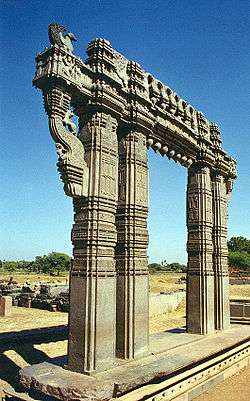 |
|
People |
|
Languages |
|
Cuisine |
|
Arts and Crafts • Music of Telangana • Shadow Puppets of Telangana |
|
Literature |
|
Tourism |
|
Cinema |
|
|
Festivals
Festivals are celebrated with much fervor and people used to go to temples on these days to offer special prayers.Some of the Festivals are Dasara, Eid ul fitr, Bakrid, Ugadi, Makara Sankranti, Guru Purnima , Sri Rama Navami, Hanuman Jayanti, Raakhi Pournami, Vinayaka Chaviti , Nagula Panchami, Krishnashtami, Deepavali,Mukkoti Ekadasi, Karthika Purnima and Ratha Saptami
Regional festivals

Telanganites not only celebrate the main festivals, but also celebrate certain regional festivals like Bonalu in Hyderabad, Batukamma[8] all over Telangana districts, Yedupayala Jatara in Medak, Sammakka Saralamma in Warangal district.
Literature
Muhammad Quli Qutb Shah was the first Saheb-e-dewan Urdu .[9] Other poets of Telangana from the early era include Kancherla Gopanna or Bhakta Ramadasu, Gona Budda Reddy, Palkuriki Somanatha, Mallinātha Sūri, and Hulukki Bhaskara. In the modern era poets include such figures as Padma Vibhushan, Kaloji Narayana Rao, Sahitya Akademi Award recipient Daasarathi Krishnamacharyulu, and Jnanpith Award recipient C. Narayana Reddy, as well as P. V. Narasimha Rao, ninth prime minister of India. Samala Sadasiva was selected for the Kendra Sahitya Puraskaram distinction. His book Swaralayalu on the subject of Hindustani classical music won the award for the year 2011.[10]
Clothing
.jpg)
Telangana is the home to some of the finest historical cloth making/fashion and dying traditions of the world. Its rich cotton production, with its innovative plant dye extraction history stand next to its diamond mining. Traditional Women wear sari in the most parts of the state.Langa Voni, Shalwar kameez and Churidaar is popular among the Unmarried Women.
Some of the famous sarees made in Telangana are Pochampally Saree, Gadwal sari.Pochampally sarees have been popular since early 1800s. In 19th century popular with traders in the silk route which symbolised luxury and power. Found place in UNESCO tentative list of world heritage sites as part of 'iconic saree weaving clusters of India'.Pochampally saree received Intellectual Property Rights Protection or Geographical Indication (GI) status in 2005.[11]
Male Clothing includes the traditional Dhoti also known as Pancha .The Hyderabadi Sherwani was the dress of choice of the Nizam of Hyderabad and Hyderabadi nobles. The Hyderabadi sherwani is longer than normal sherwani reaching below the knees.[12] Sherwani is usually worn during the wedding ceremonies by the groom. A scarf called a dupatta is sometimes added to the sherwani.
Cuisine
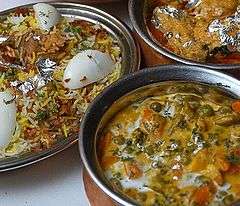
Telangana has two types of cuisines, the Telugu cuisine and Hyderabadi cuisine. Telugu cuisine is the part of South Indian cuisine characterized by their highly spicy food.The Telangana state lies on the Deccan plateau and its topography dictates more millet and roti (leavened bread) based dishes. Jowar and Bajra features more prominently in their cuisine. Due to its proximity with Maharashtra, Chhattisgarh and northwest Karnataka, it shares some similarities of the Deccan plateau cuisine. The region has the spiciest food amongst all other Telugu and Indian cuisines.Telangana has some unique dishes in its cuisine, such as jonna rotte (sorghum), sajja rotte (penisetum), or Uppudi Pindi (broken rice). In Telangana a gravy or curry is called Koora and Pulusu (Sour) in based on Tamarind. A deep fry reduction of the same is called Vepudu. Kodi pulusu and Mamsam (meat) vepudu are popular dishes in meat. Vankaya Brinjal Pulusu or Vepudu, Aritikaya Banana pulusu or Vepudu are one of the many varieties of vegetable dishes.[13] Telangana palakoora is a spinach dish cooked with lentils eaten with steamed rice and rotis. Peanuts are added as special attraction and in Karimnagar District, cashew nuts are added.
Sakinalu also called as Chakinalu, is one of the most popular savory in Telangana, is often cooked during Makara Sankranti festival season. This a deep-fried snack made of rice flour, sesame seeds and flavoured with ajwain (carom seeds or vaamu in Telugu). These savories are harder and spicier than the Andhra varieties. Garijelu is a dumpling dish similar to the Maharashtrian karanji, which in Telangana is cooked with sweet stuffing or a savory stuffing with mutton or chicken kheema.[14]
Hyderabadi cuisine, an amalgamation of Persian cuisine, Mughlai, Telugu, Turkish cuisines, developed by the Qutb Shahi dynasty and the Nizams of Hyderabad. It comprises a broad repertoire of rice, wheat and meat dishes and various spices and herbs.[15][16]
Hyderabadi cuisine is an integral part of the cuisines of the former Hyderabad State that includes the state of Telangana and the regions of Marathwada (now in Maharashtra) and Hyderabad-Karanataka (now in Karnataka). The Hyderabadi cuisine contains city specific specialties like Hyderabad (Hyderabadi biryani and Hyderabadi Haleem)[17] and Aurangabad (Naan Qalia), Gulbarga (Tahari), Bidar (Kalyani Biryani) and others. The use of dry coconut, tamarind, and red chillies along with other spices are the main ingredients that make Hyderabadi cuisine different from the North Indian cuisine
Religion
The major religions of the people are Hinduism and Islam,[18] though Buddhism was the dominant religion up to the 6th century. It is the home of Mahayana Buddhism as revealed by the monuments of Nagarjunakonda. Acharaya Nagarjuna presided over the World University at Sri Parvata. Hinduism was revived in the time of the Chalukyas and the Kakatiyas in the 12th century. The Vijayanagar rule saw the glorious days of Hinduism when the famed emperors, Krishnadeva Raya in particular, built new temples and beautified the old ones. Siva, Vishnu, Hanuman and Ganapati have been the popular Hindu Gods. The Vugra Narasimha swami Temple at Yadagirigutta and Thousand Pillar Temple at Warangal are among the oldest shrines in the state attracting people from different parts of the country for hundreds of years.
In terms of influence, Islam occupies the second place. It started spreading from the 14th century onwards. Mosques began to come up in many parts of the region during the Muslim rule. Christianity began to spread from 1701, Especially among the socially disabled people. Educational institutions and churches grew in number in the Circars in the 18th and 19 centuries when the East India Company and later the British government encouraged them. Other European countries were also active in building churches and taking care of the weaker sections of the people.
Pilgrimages in Telangana
Yadadri : Lord Vishnu (whose reincarnation is Lord Narasimha). The main deity is Lakshmi Narasimha Swamy.[19] Located in Yadadri District. In Ancient days Sri Yada Maharshi son of Sri Rushyashrunga Maharshi with the Blessings of Anjaneya Swamy had performed great penance for Lord Narasimha Swamy. After securing blessing for his penance Lord Narasimha had come into existence in Five Avatharas called as Sri Jwala Narasimha, Sri Yogananda Narasimha, Sri Ugra Narasimha, Sri Gandaberunda Narasimha, Sri Lakshmi Narasimha. As such this is known as “Pancha Narasimha Kshetram”.
Bhadrachalam Temple is a Lord Sree Sita Ramachandra Swamy Temple in Bhadrachalam, Bhadradri District. Bhadrachalam-The name derived from Bhadragiri (Mountain of Bhadra-a boon child of Meru and Menaka). According to an Ithihasas, the significance of this shrine dates back to the Ramayana Era. This coherent hill place existed in "Dandakaranya" Of Ramayana period where Rama with his consort Sita and brother Laxmana had spent their vanavasa- and Parnashaala(the place connected to the famous Golden Deer and the place from where Sita was abducted by Ravana.) is also in the vicinity of this temple site. It is at this Mandir site that, long after Ramavatara, Bhagawan Mahavishnu manifested Himself as Rama again to fulfil a promise He made to His Bhakta Bhadra, who continued his Tapas through Yugas, praying for the grace of the Bhagawan Sri Ramachandra murthy.[20]
Jamalapuram Temple is a Lord Sree Venkateswara Swamy Temple in Jamalapuram, near Errupalem, Khammam District is a famous temple in Khammam district of Telangana and is famously known as Telangana Tirupathi. The presiding deity in this temple is Lord Balaji and is said to be a swayambhu Lord, who self-manifested in this place. Since it is a swayambhoo temple, this temple seems to have been in existence from thousands of years. It was renovated by Sri Krishna Devarayalu, the emperor of Vijayanagara kingdom. The temple is located in a serene pleasant ambience surrounded by lush green hills. The temple has sub-shrines for Padmavathi Ammavaru, Sri Alivelu Ammavaru, Lord Shiva, Lord Ganesh, Lord Ayyappa, and Lord Anjaneya.
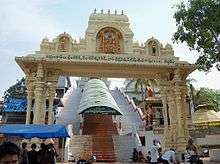
Sri Raja Rajeshwara temple, Vemulawada is a site of pilgrimage for both Hindu (particularly devotees of Vishnu and Shiva) and Muslim worshippers. Built by Chalukya Kings between AD 750 and 975, the complex is named for its presiding deity Sri Raja Rajeswara Swamy, an incarnation of Lord Shiva. It houses several temples dedicated to other deities including Sri Rama, Lakshmana, Lakshmi, Ganapathy, Lord Padmanabha Swamy and Lord Bhimeshwara.This Shrine is popularly known as ‘Dakshina Kasi’ [Southern Banaras][21] and also as “Harihara Kshetram” for their being two Vaisnava Temples in main Temple complex i.e., Sri Anantha Padmanabha Swamy Temple & Sri Seetharama Chandra Swamy Temple The complex also contains a 400-year-old mosque which stands as an ample evidence for religious tolerance .The temple is located in Karimnagar District.
Birla Mandir, Hyderabad: Built on a 280 feet (85 m) high hillock called Naubath Pahad on a 13 acres (53,000 m2) plot in Hyderabad
Basara: Gnana Saraswati Temple (Goddess of Knowledge) is located on the banks of the river Godavari in Adilabad District
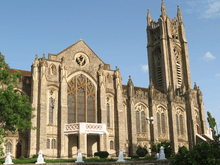
Mecca Masjid, is one of the oldest mosques in Hyderabad, Telangana in India, And it is one of the largest Mosques in India. Makkah Masjid is a listed heritage building in the old city of Hyderabad, close to the historic landmarks of Chowmahalla Palace, Laad Bazaar, and Charminar. Muhammad Quli Qutb Shah, the fifth ruler of the Qutb Shahi dynasty, commissioned bricks to be made from the soil brought from Mecca, the holiest site of Islam, and used them in the construction of the central arch of the mosque, thus giving the mosque its name. It formed the centerpiece around which the city was planned by Muhammad Quli Qutub Shah.[22]
Medak Church at Medak in Telangana, India, is the largest church in Telangana and has been the cathedral church of the Diocese of Medak of the Church of South India since 1947. Originally built by British Wesleyan Methodists, it was consecrated on 25 December 1924. The Medak diocese is the single largest diocese in Asia and the second in the world after the Vatican.[23] The church was built under the stewardship of the Methodist Christian, the Reverend Charles Walker Posnett, who was driven by the motto My best for my Lord. Charles Posnett had arrived in Secunderabad in 1895, and after first ministering among British soldiers at Trimullghery, had launched into the villages and had reached Medak village in 1896.[24]
Banjara (Lambadi) Spiritual/Religious Persons
Jairam Bapuji,[25] Sevya Bapuji[26] are the very famous Banjara Or Lambadi Spiritual Persons from Balu Thanda / Jairam Thanda, Madgul Mandal, Mahabubnagar District,Telangana.
Performing arts
Dance
Perini Sivatandavam or Perini Thandavam is an ancient dance form from Telangana which has been revived in recent times.[27] It originated and prospered in Telangana during the Kakatiya dynasty.
The Perini Thandavam is a dance form usually performed by males. It is called 'Dance of Warriors'. Warriors before leaving to the battlefield enact this dance before the idol of Lord Siva. The dance form, Perini, reached its pinnacle during the rule of the 'Kakatiyas' who established their dynasty at Warangal and ruled for almost two centuries.It is believed that this dance form invokes 'Prerana' (inspiration) and is dedicated to supreme dancer, Lord Siva.
Bonalu The folk festival of Bonalu in the Telangana region brings with it celebrations which see the colourfully dressed female dancers balancing pots (Bonalu), step to the rhythmic beats and tunes in praise of the village deity Mahankali. Male dancers called Potharajus precede the female dancers to the temple lashing whips and neem leaves adding colour to the festivity.
Music
Telangana has a diverse variation of Music from Carnatic Music to Folk music.Kancherla Gopanna,[28] popularly known as Bhakta Ramadasu or Bhadrachala Ramadasu was a 17th-century Indian devotee of Rama and a composer of Carnatic music. He is one among the famous vaggeyakaras (a person who not only composes the lyrics but also sets them to music; vāk = word, speech; geya = singing, singable; geyakāra = singer) in the Telugu language.
The folk songs of Telangana had left a profound impact on the Statehood movement[29] as it played a significant role in the success of the Dhoom-Dham, a cultural event that was a vital part of the agitations.
Oggu Katha
Oggu Katha or Oggukatha is a traditional folklore singing praising and narrating the stories of Hindu gods Mallana, Beerappa and Yellamma.[30] It originated among the Yadav and Kuruma Golla communities, who devoted themselves to the singing of ballads in praise of Lord Shiva (also called Mallikarjuna).[31] These tradition-loving and ritual-performing community moves from place to place, narrating the stories of their caste gods. Oggus are the traditional priests of the Yadavas and perform the marriage of Mallanna with Bhramaramba.
The narrator and his chorus i.e. two narrators-help in dramatizing the narration as very often, they transform themselves into two characters. The dramatization of the narrative is what gives the Oggu Katha its predominant place in the ballad tradition in Telangana, where Oggu Katha prevalent. They singers visit the shrine of Komrelly Mallanna Temple every year.

Cinema
Telugu cinema, also known by its sobriquet as Tollywood, is a part of Indian cinema producing films in the Telugu language, and is centered in the Hyderabad, Telangana neighbourhood of Film Nagar.[32] The industry holds the Guinness World Record for the largest film production facility in the world, Ramoji Film City.[33] The Prasads IMAX located in Hyderabad is one of the largest 3D IMAX screen, and the most attended cinema screen in the world.[34][35][36] As per the CBFC report of 2012, the industry is placed second in India, in terms of films produced yearly.[37]
Visual Arts
Paintings
Nirmal Paintings are a popular form of paintings done in Nirmal in Adilabad District.The paintings have golden hues.[38][39] The region is well known for its Golconda and Hyderabad painting styles which are branches of Deccani painting.[40] Developed during the 16th century, the Golconda style is a native style blending foreign techniques and bears some similarity to the Vijayanagara paintings of neighbouring Mysore. A significant use of luminous gold and white colours is generally found in the Golconda style.[41] The Hyderabad style originated in the 17th century under the Nizams. Highly influenced by Mughal painting, this style makes use of bright colours and mostly depicts regional landscape, culture, costumes and jewellery.[40]
Sculpture
Ramappa Temple:It lies in a valley at Palampet village of Venkatapur Mandal, in erstwhile Mulug Taluq of Warangal district, a tiny village long past its days of glory in the 13th and 14th centuries.[42] An inscription in the temple dates it to the year 1213 and said to have been built by a General Recherla Rudra, during the period of the Kakatiya ruler Ganapati Deva.
This medieval temple is a Shivalaya (where Shiva is worshipped) and named after the sculptor Ramappa. It is the only temple in the world named after its sculptor/architect. Its presiding deity, Ramalingeswara, is the form of Shiva and a personal god of the Avatar of Vishnu, Rama. The history says that it took 40 years to build this temple. Planned and sculpted by Ramappa, the temple was built on the classical pattern of being lifted above the world on a high star-shaped platform. Intricate carvings line the walls and cover the pillars and ceilings. Starting at its base to its wall panels, pillars and ceiling are sculpted figures drawn from Hindu mythology.[43] The roof (garbhalayam) of the temple is built with bricks, which are so light that they are able to float on water.[44]
Architecture

The Thousand Pillar Temple is one of the very old temples of South India that was built by the kakatiyas.[45] It stands out to be a masterpiece and achieved major heights in terms of architectural skills by the ancient kakathiya vishwakarma sthapathis. It is believed that the Thousand Pillar Temple was built by King Rudra Deva in 1163 AD. The Thousand Pillar Temple is a specimen of the Kakatiyan style of architecture of the 12th century.
It was destroyed by the Tughlaq dynasty during their invasion of South India. It consists one temple and other building. There are one thousand pillars in the building and the temple, but no pillar obstructs a person in any point of the temple to see the god in the other temple.
Alampur Temples:There are a total of nine temples in Alampur. All of them are dedicated to Shiva. These temples date back to the 7th century A.D and were built by the Badami Chalukyas rulers who were great patrons of art and architecture. Even after a time span of several hundred years, these grand temples still stand firm reflecting the rich architectural heritage of the country.
The temples are emblematic of the Northern and Western Indian styles of architecture. They do not reflect the Dravidian style of architecture as is generally common with the temples in this region.The shikharas of all these temples have a curvilinear form and are adorned with the miniature architectural devices. The plans and decoration similar to that of the rock cut temples.The Alampur Navabhrama Temples are historically important and reflect remarkable architectural skills.
Alampur was previously Known as Halampuram, Hamalapuram And Alampuram. Name of this place as Hatampura, mentioned in the inscription dated AD 1101 belongs to Western Chalukya[46]
Cultural sites
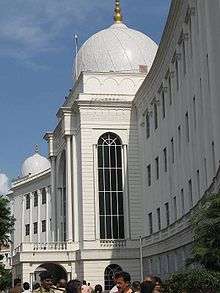
Telangana has many museums which depicts the culture of the erstwhile Kingdoms of the state.The Salar Jung Museum is an art museum located on the southern bank of the Musi river in the city of Hyderabad, Telangana, India. It is one of the three National Museums of India.[47] The museum's collection was sourced from the property of the Salar Jung family.The Salarjung Museum is the third largest museum in India housing the biggest one-man collections of antiques in the world. It is well known throughout India for its prized collections belonging to different civilizations dating back is very largest accocation to the 1st century.The other prominent Museums are Nizam Museum, City Museum, Hyderabad and Birla Science Museum.
References
- ↑ "A brew of Telangana culture". 16 September 2014. Retrieved 27 July 2016.
- ↑ Telangana Culture Archived 14 February 2015 at the Wayback Machine.
- ↑ "Ganga-Jamuni tehzeeb helps maintain peace". deccanchronicle.com. Retrieved 13 January 2016.
- ↑ "Ganga-Jamuni tehzeeb: Temple serving Iftar Dates to 5 Mosques in Hyderabad". The Siasat Daily. Retrieved 13 January 2016.
- ↑ "Region-wise distribution of religious groups 2001" (PDF). Table 7.3 in page 393 of SKC report. Retrieved 3 June 2014.
- ↑ "Urdu in Andhra Pradesh". Language in India. Retrieved 22 January 2013.
- ↑ "Census of India – Distributions of 10,000 persons by language". www.censusindia.gov.in. Retrieved 14 September 2010. – People not interested in dividing Andhra Pradesh.
- ↑ Gollapudi Srinivasa Rao. "Bathukamma festivities to begin from Sept. 24". The Hindu. Retrieved 13 January 2016.
- ↑ "A Sheikh's tryst with Urdu poetry". The Hindu. 2 May 2010. Retrieved 2 June 2014.
- ↑ "Sahitya Akademi award for Samala Sadasiva". The Times of India. 22 December 2011. Retrieved 2 June 2014.
- ↑ https://web.archive.org/web/20130512022824/http://textilescommittee.nic.in/GI-Research.htm. Archived from the original on 12 May 2013. Retrieved 20 November 2014. Missing or empty
|title=(help) - ↑ "Define sherwani - Dictionary and Thesaurus". askdefine.com. Retrieved 13 January 2016.
- ↑ "Needs title". indianexpress.com. The New Indian Express. 29 January 2014. Archived from the original on 18 September 2013. Retrieved 22 February 2014.
- ↑ "Needs title". The New Indian Express. 29 January 2014. Archived from the original on 18 September 2013. Retrieved 22 February 2014.
- ↑ Sanjeev Kapoor; Harpal Singh Sokhi (2008). Royal Hyderabadi Cooking. Popular Prakashan. p. 3. ISBN 978-81-7991-373-4. Retrieved 8 December 2013.
- ↑ Karen Isaksen Leonard (2007). Locating Home: India's Hyderabadis Abroad. Stanford University Press. p. 14. ISBN 978-0-8047-5442-2. Retrieved 8 December 2013.
- ↑ "Biryani, Haleem & more on Hyderabad's menu". The Times of India. Retrieved 13 January 2016.
- ↑ Religion Distribution
- ↑ "Homam performed at Yadagirigutta". The Hindu. Retrieved 13 January 2016.
- ↑ ":: Welcome to Bhadrachala Sree Seetha Ramachandra swamy temple ::". bhadrachalarama.org. Retrieved 13 January 2016.
- ↑ "Vemulawada Temple - Sri Raja Rajeswara Swamy Devasthanam: History". vemulawadatemple.org. Retrieved 13 January 2016.
- ↑ "Mecca Mosque". Encyclopedia Britannica. Retrieved 3 November 2011.
- ↑ "Medak Cathedral". Prasar Bharti (All India Radio). 25 September 2013. Retrieved 25 September 2013.
- ↑ Medak Diocese
- ↑ "List Lambadi Religious Gurus and saints". Lambadiwala.
- ↑ "Banjara Religious Gurus". LambadiYOUTH.
- ↑ "Telangana Natyam, Perini dance in temples across State". The Hindu. Chennai, India. 16 October 2010.
- ↑ "The Hindu : Entertainment Hyderabad / Dance : Bhakta Ramadas staged". thehindu.com. Retrieved 13 January 2016.
- ↑ K.M. Dayashankar/B. Chandrashekhar. "Folk songs set tune for 'T' struggle". The Hindu. Retrieved 13 January 2016.
- ↑ "Telangana Cultural Forum organises rally". The Hindu. Retrieved 13 January 2016.
- ↑ "News Archives: The Hindu". hindu.com. Retrieved 13 January 2016.
- ↑ "Year of success for tinsel town". The Hindu. Chennai, India. 26 December 2007.
- ↑ "Official Site of Guinnessworldrecords.com Largest Film studio in the world". Archived from the original on 19 January 2014.
- ↑ "CNN Travel". CNN.
- ↑ "Thehindu.com King of Good times Prasad's Imax". Chennai, India: The Hindu Newspaper. 7 August 2011.
- ↑ Dan Nosowitz (30 May 2009). "The Seven IMAX Wonders of the World". Gizmodo.com. Retrieved 10 February 2013.
- ↑ "Annual report 2011" (PDF). Central Board of Film Certification, Ministry of Information and Broadcasting, GOVERNMENT OF INDIA.
- ↑ Traditional art emporium at its finest - HYDB - The Hindu
- ↑ Staff Reporter. "Lepakshi expo inaugurated". The Hindu. Retrieved 13 January 2016.
- 1 2 "Miniature painting". Centre for Cultural Resources and Training. Archived from the original on 18 March 2013. Retrieved 9 June 2012.
- ↑ Zebrowski, Mark (1983). Deccani painting. University of California Press. pp. 40–66. ISBN 0-85667-153-3.
- James, Ralph; Lefèvre, L (2010). National exhibition of works of art, at Leeds, 1868: official catalogue. The Executive Committee. pp. 301–313. ISBN 978-1-165-04393-4.
- ↑ "The Shiva temples at Palampet". Archived from the original on 18 October 2006. Retrieved 11 September 2006.
- ↑ "Ramappa Temple - Symphony In Stone". Rakshan Sharma. Retrieved 11 September 2006.
- ↑ "Warangal Temples, Andhra Pradesh". Retrieved 11 September 2006.
- ↑ 1,000-pillar temple to get facelift - Times Of India. Articles.timesofindia.indiatimes.com (20 July 2003). Retrieved on 2013-08-25.
- ↑ "ALAMPUR". Retrieved 26 March 2009.
- ↑ [Book name: Footprint India By Roma Bradnock,ISBN 978-1-906098-05-6, p-1033]